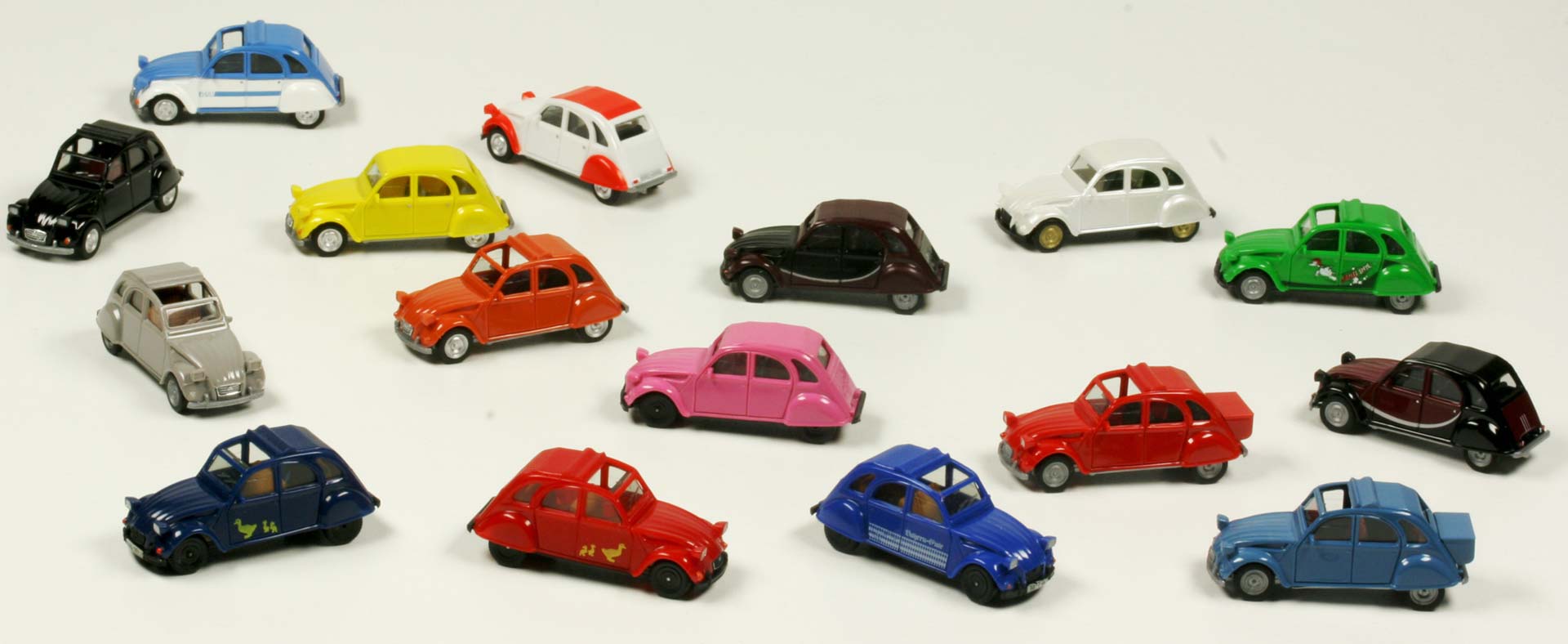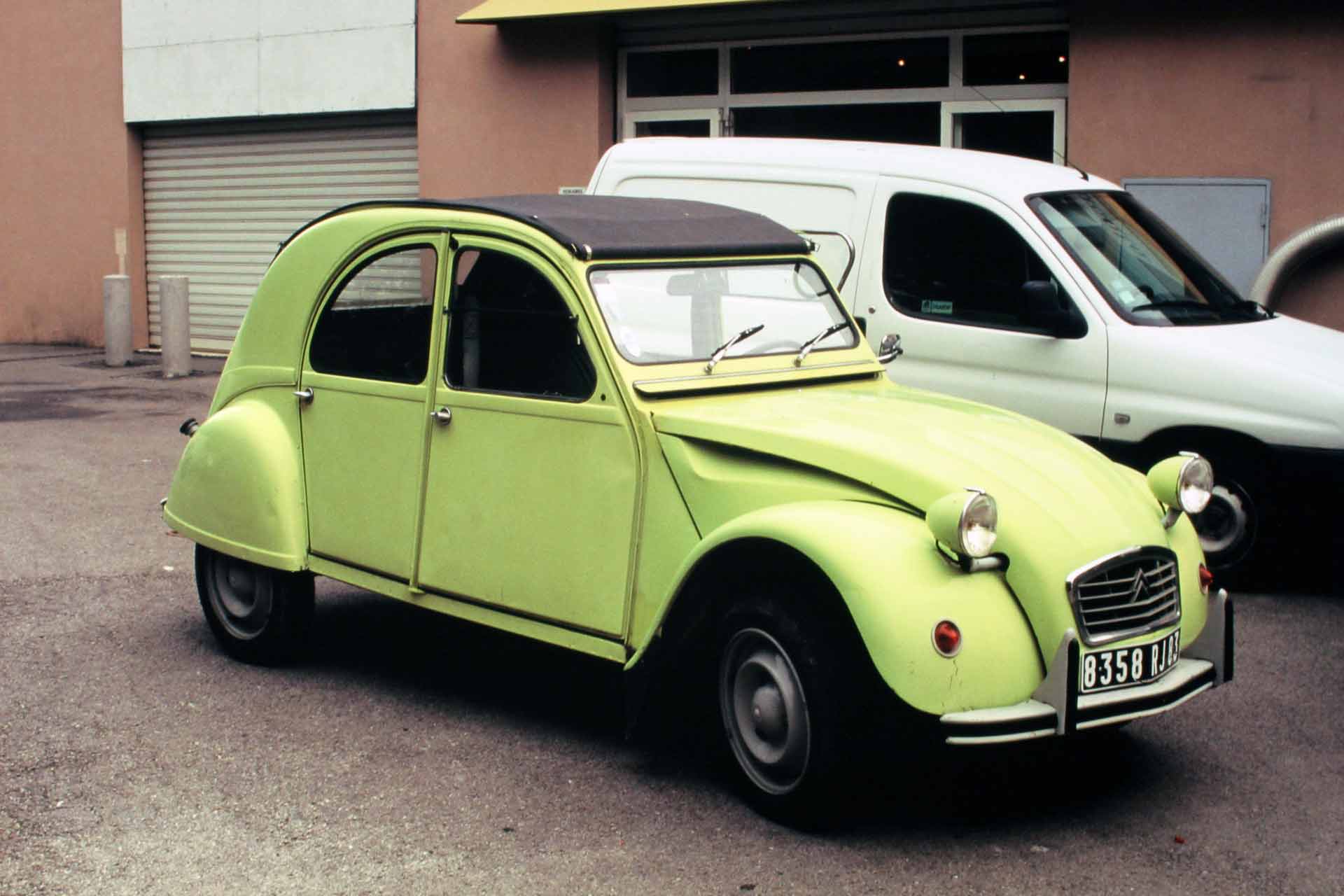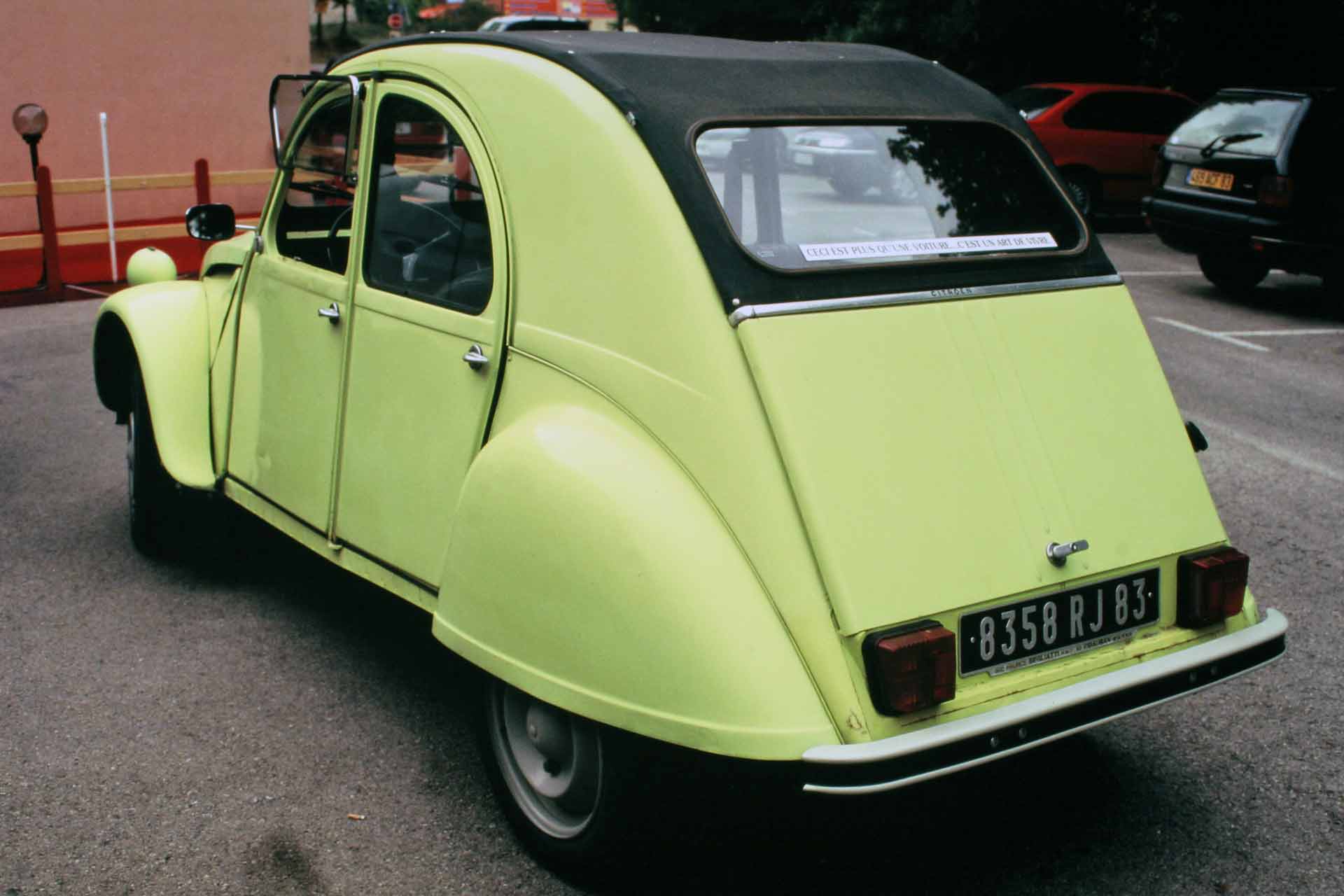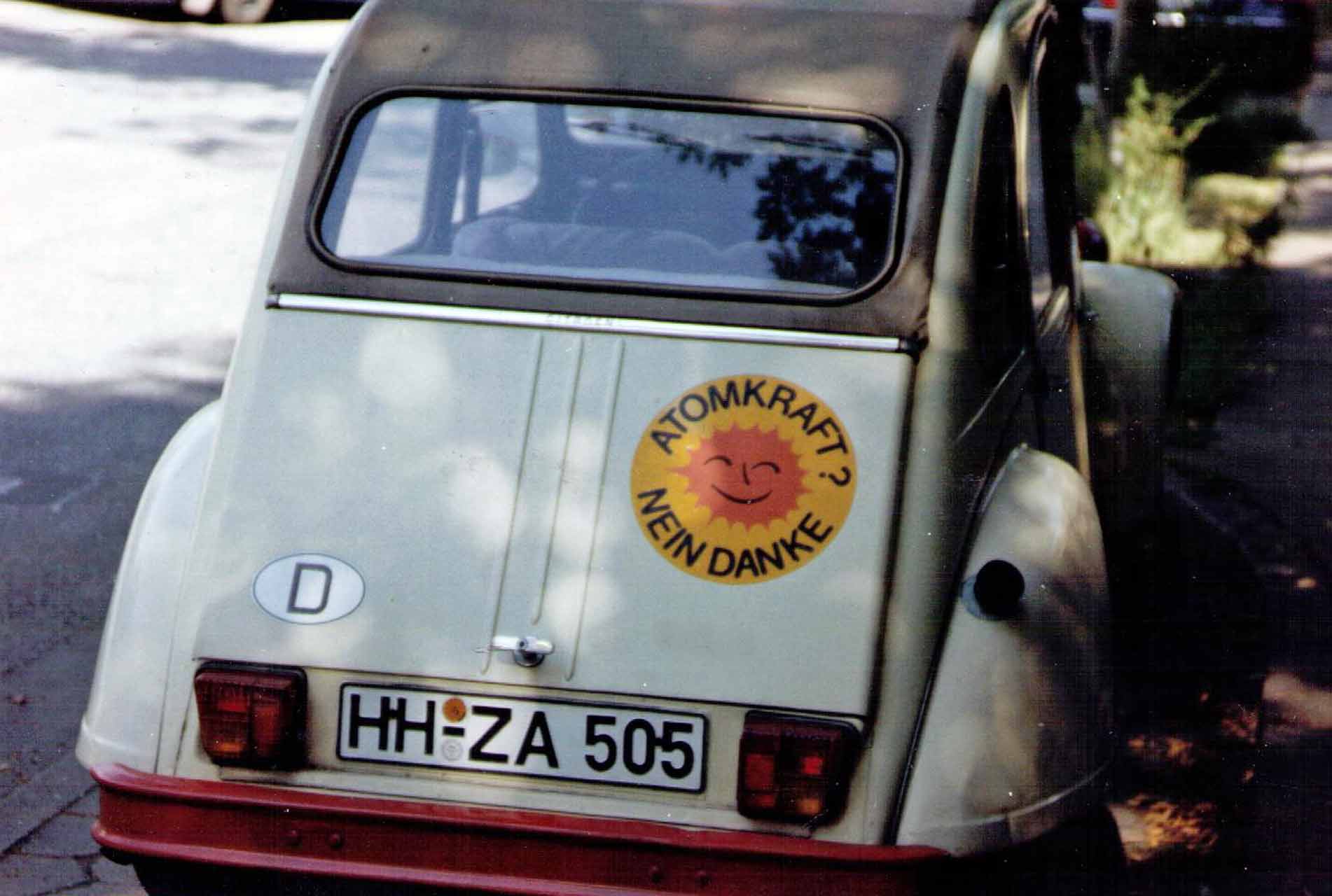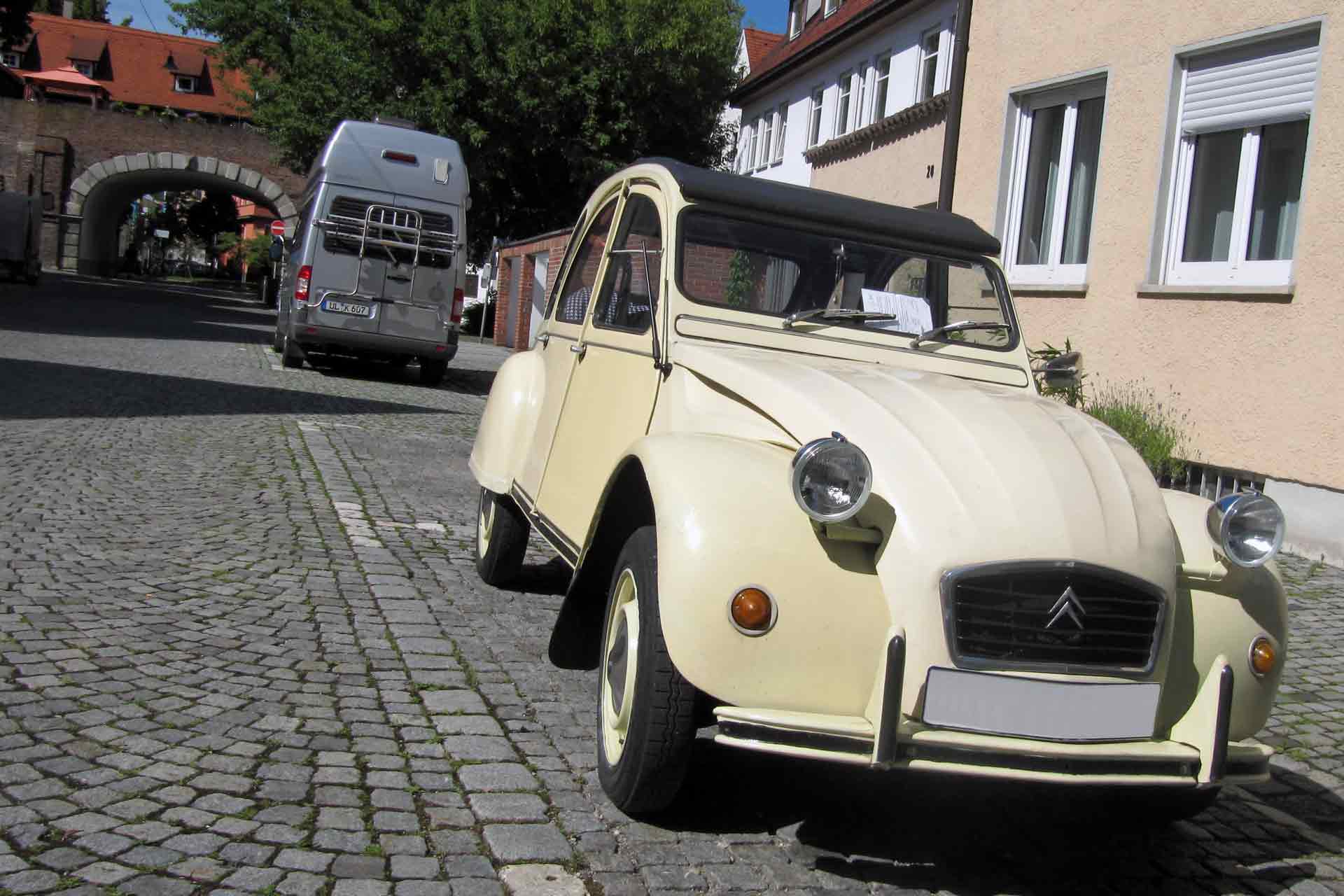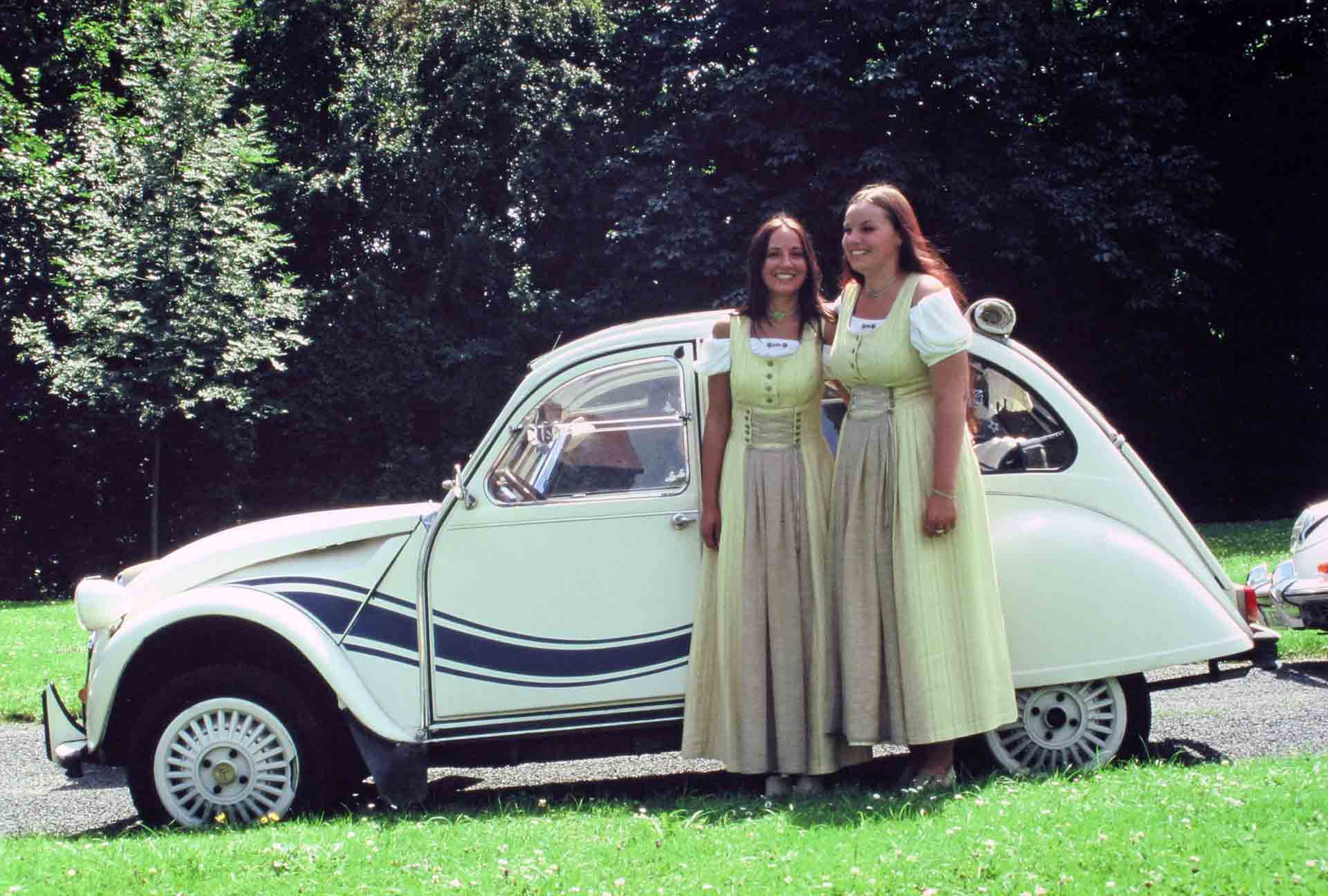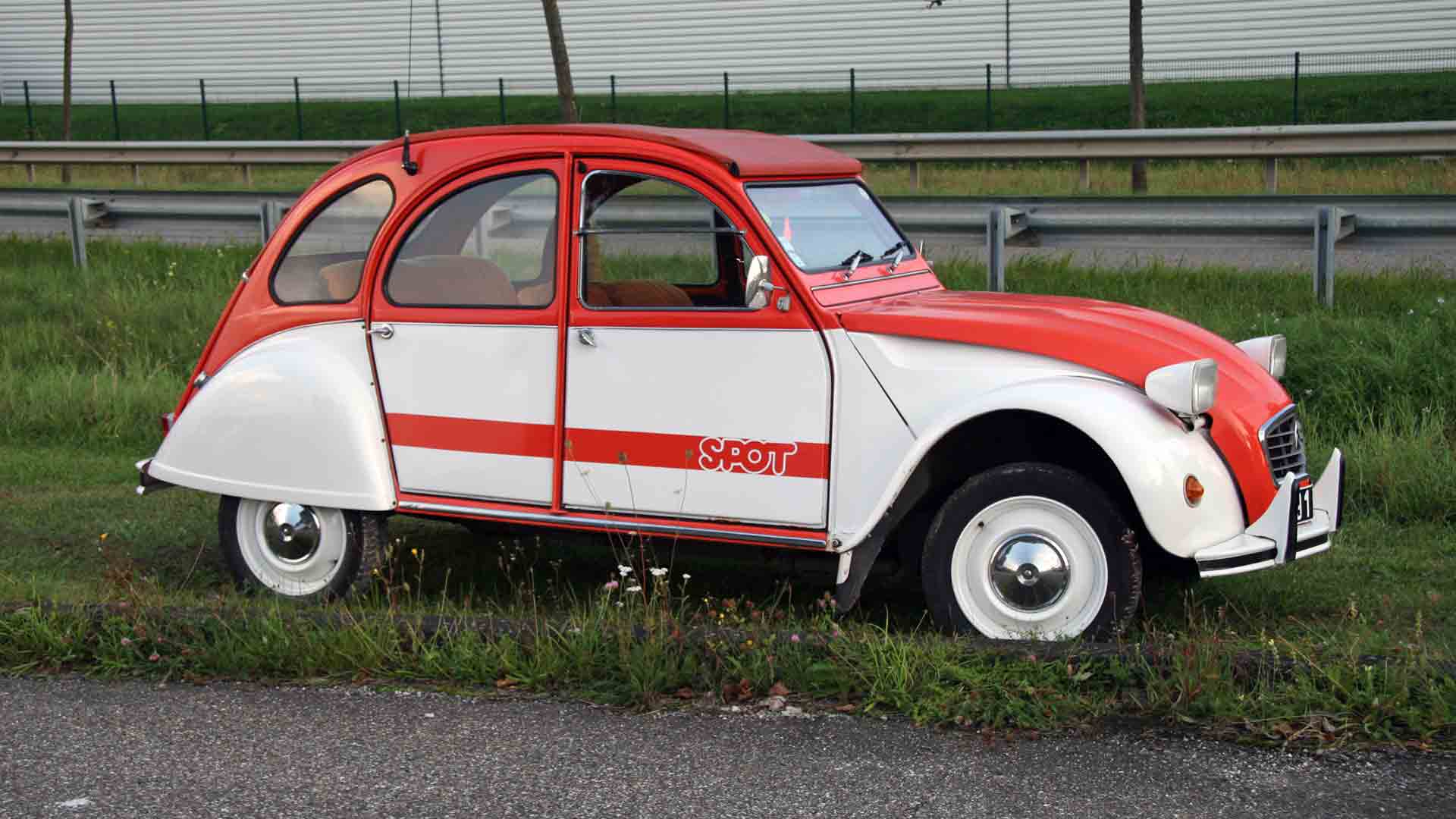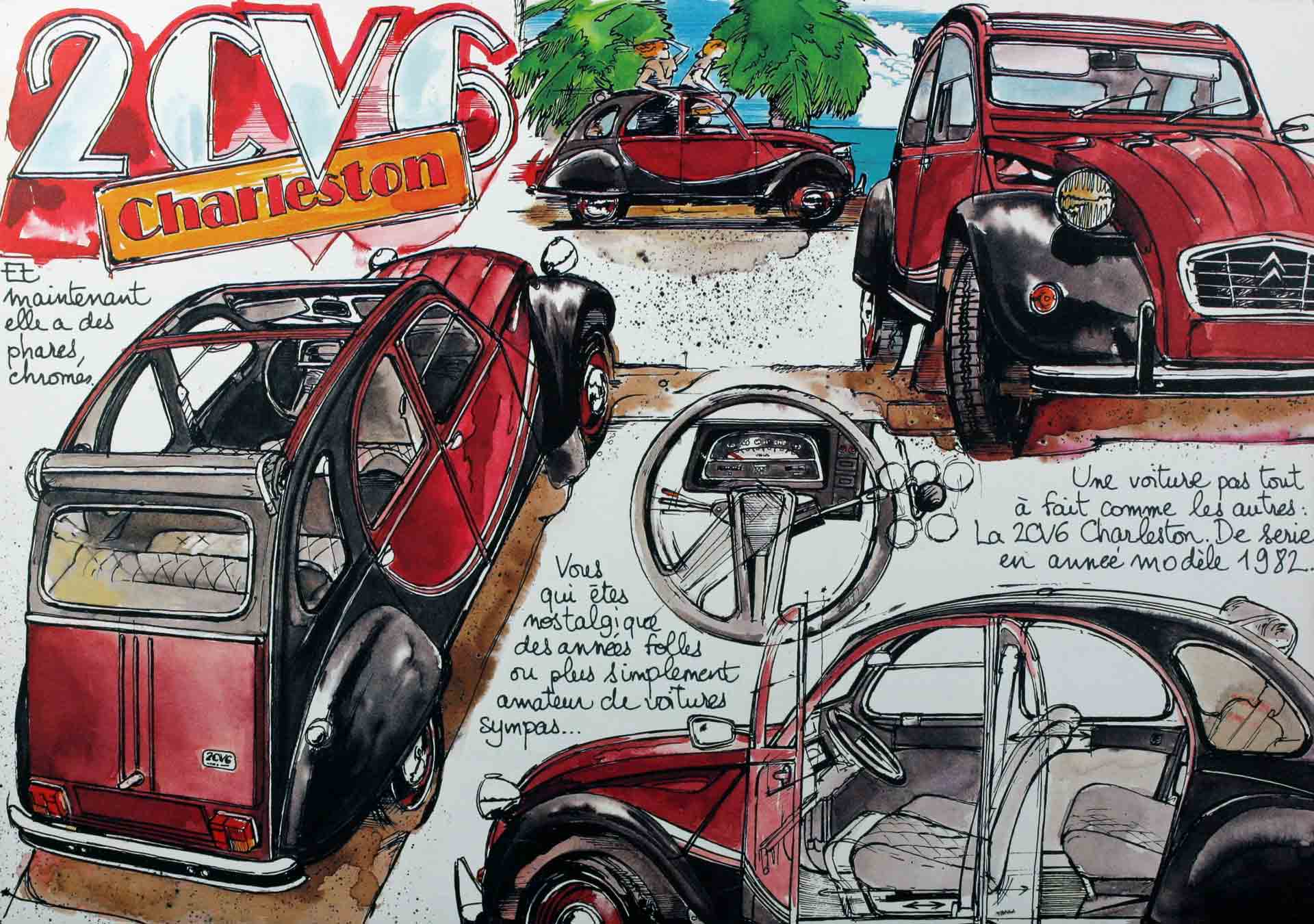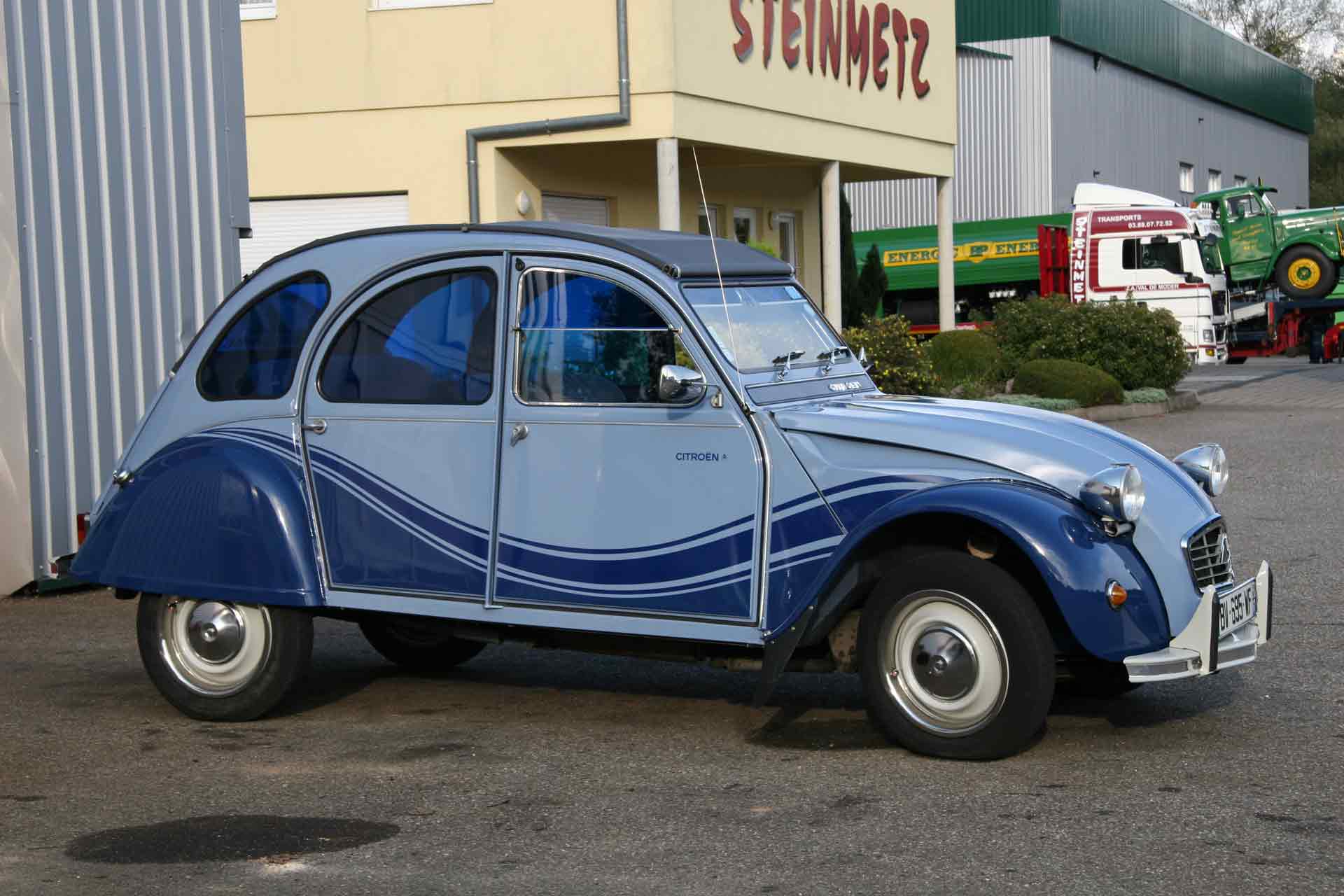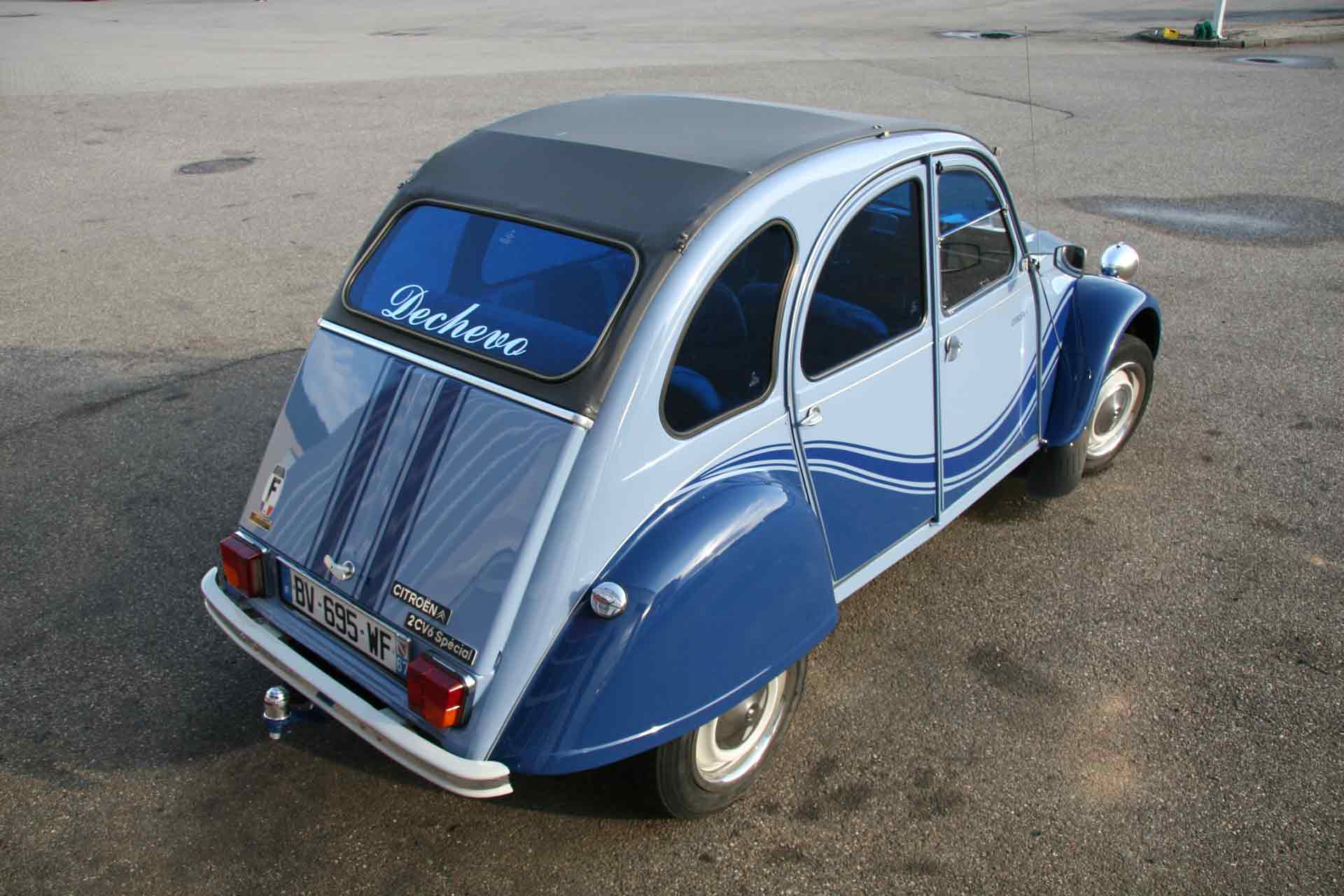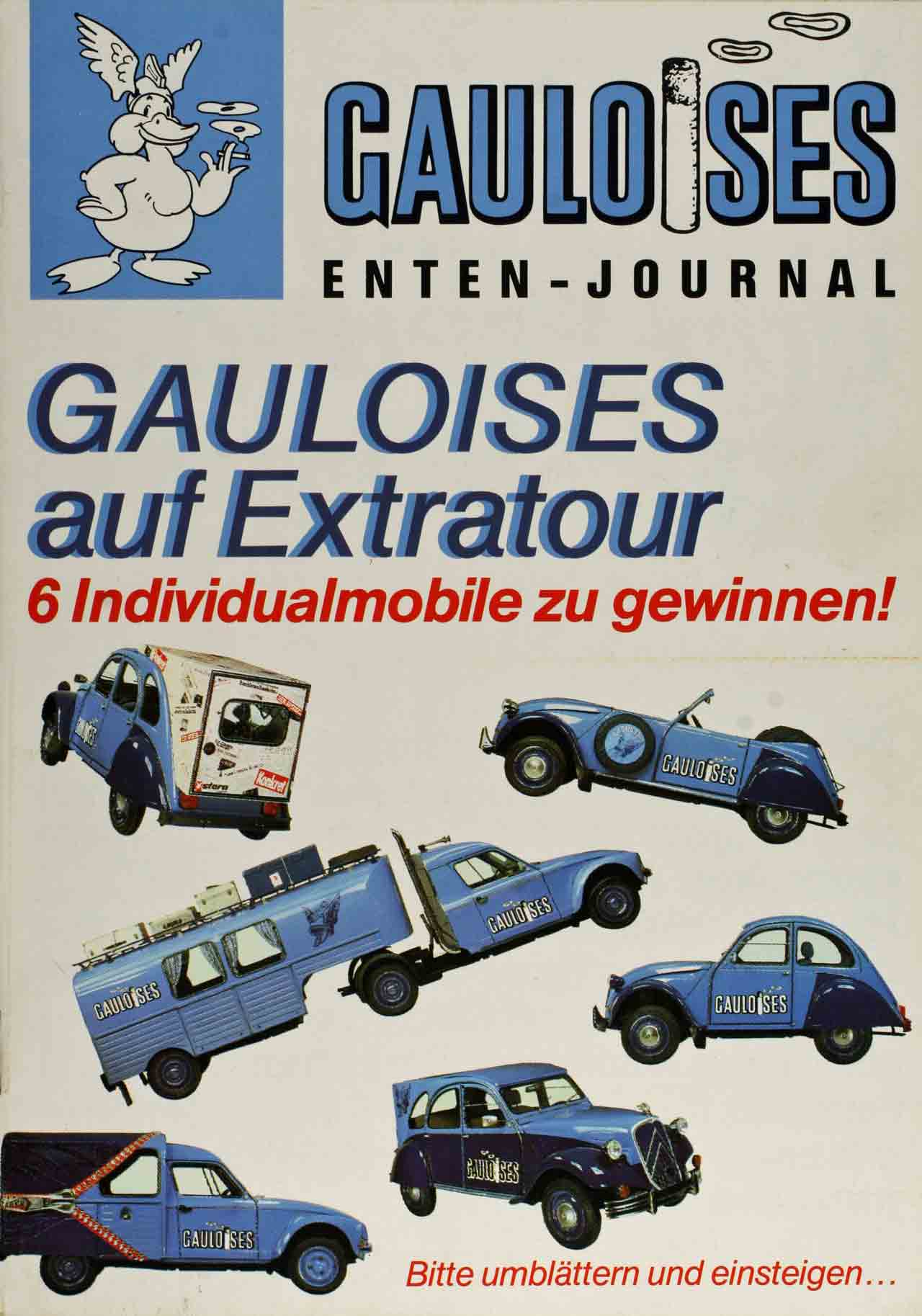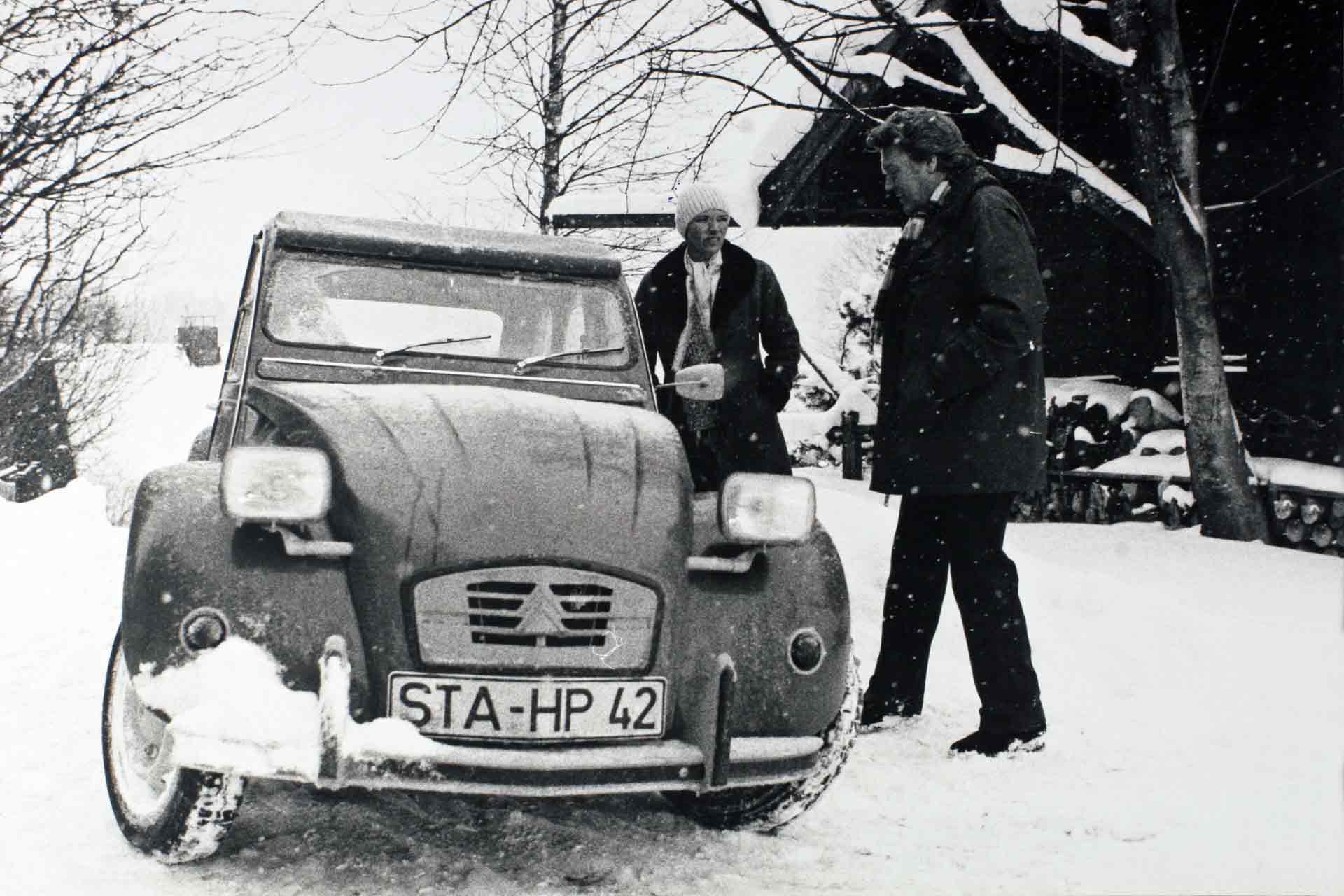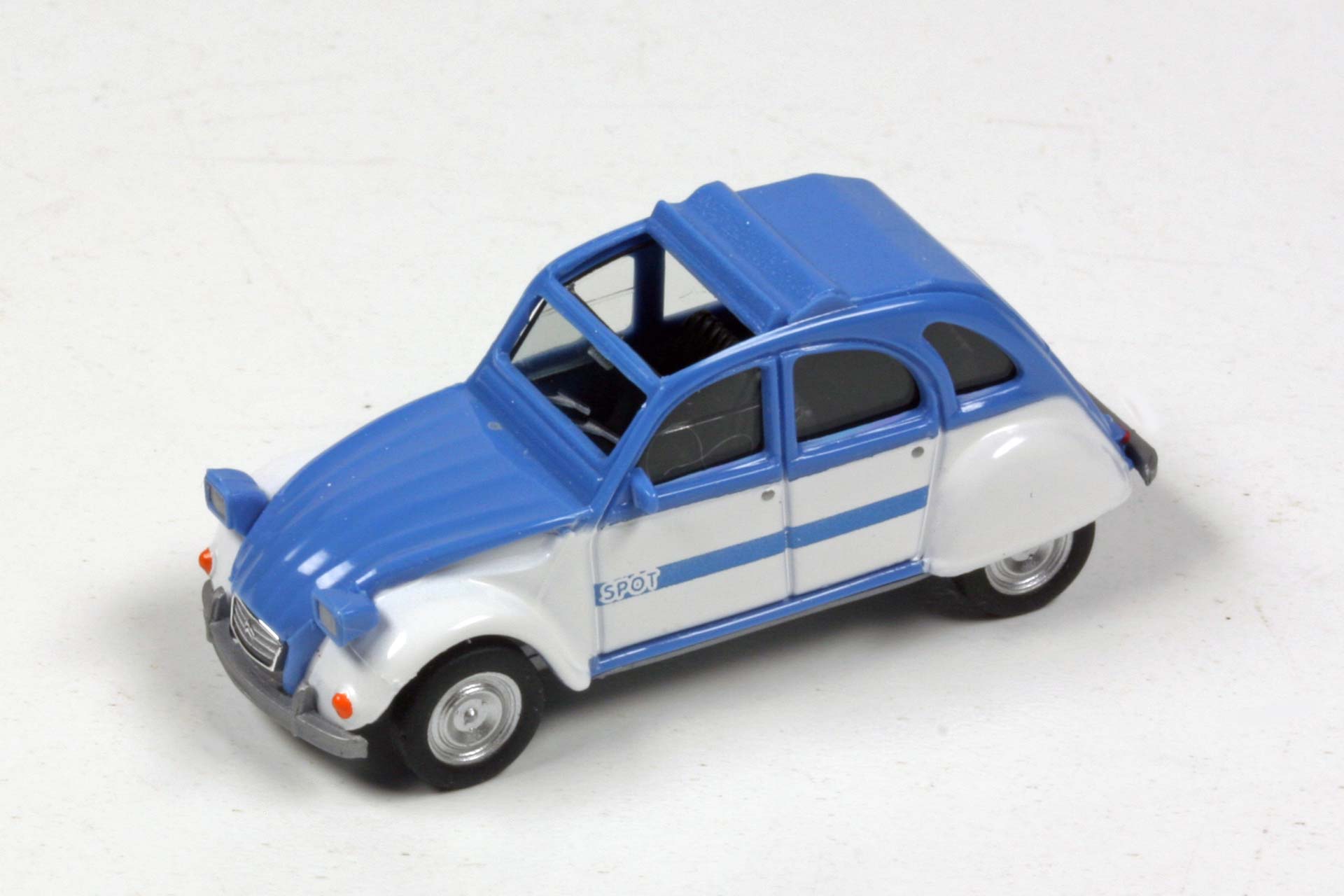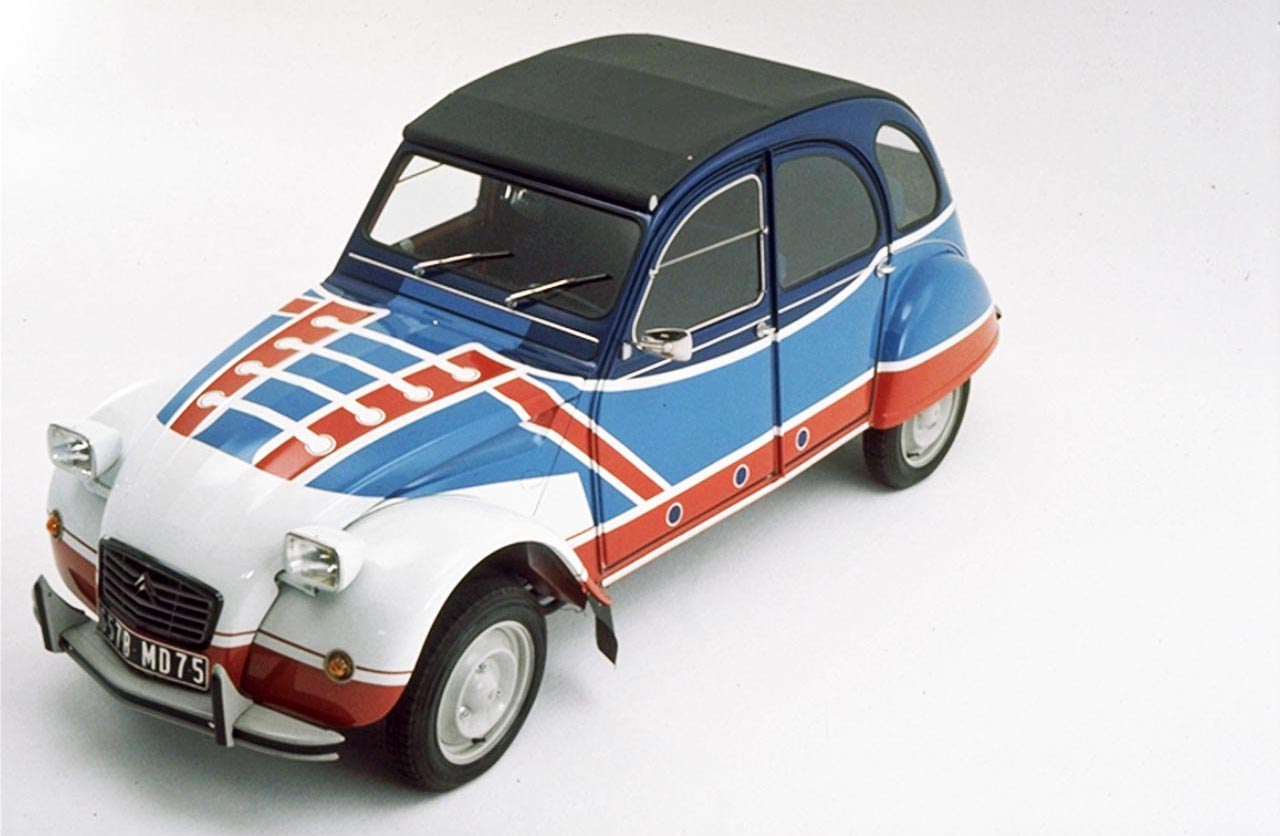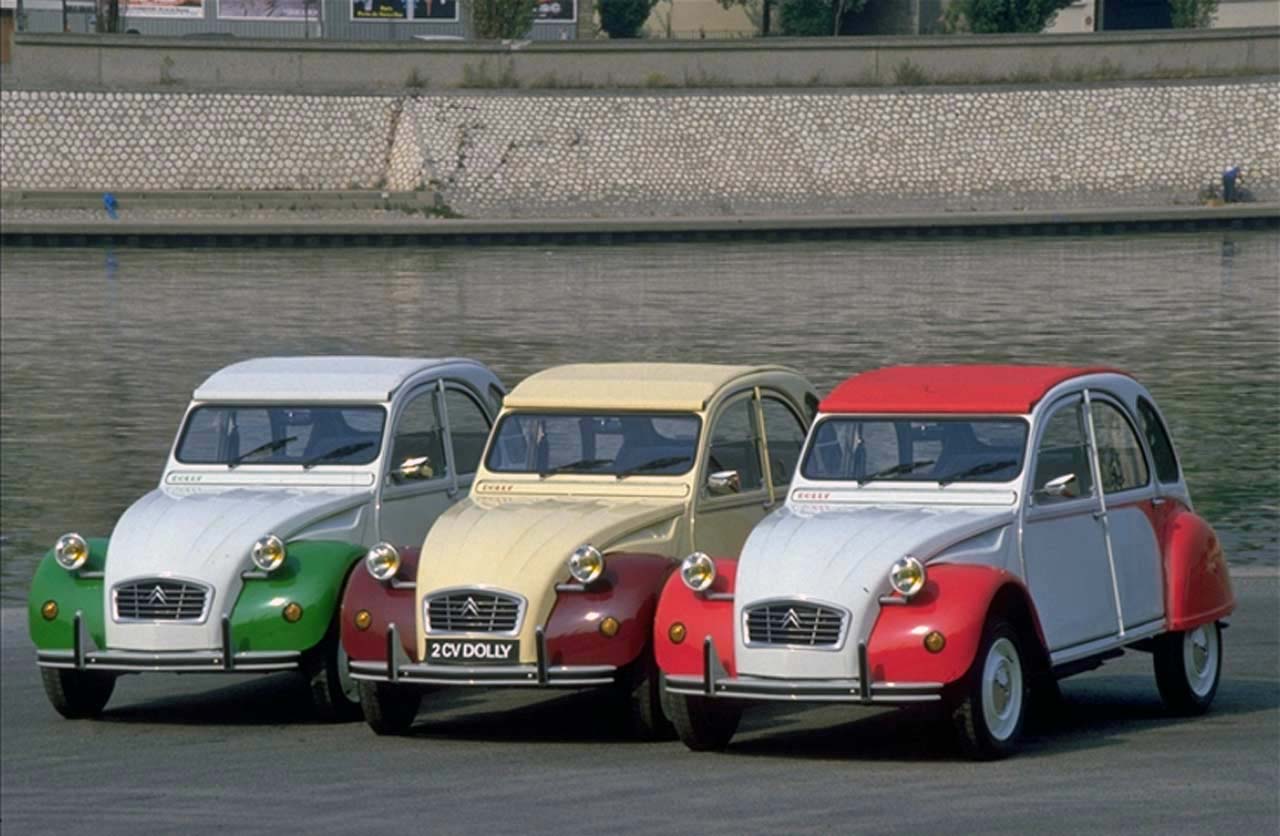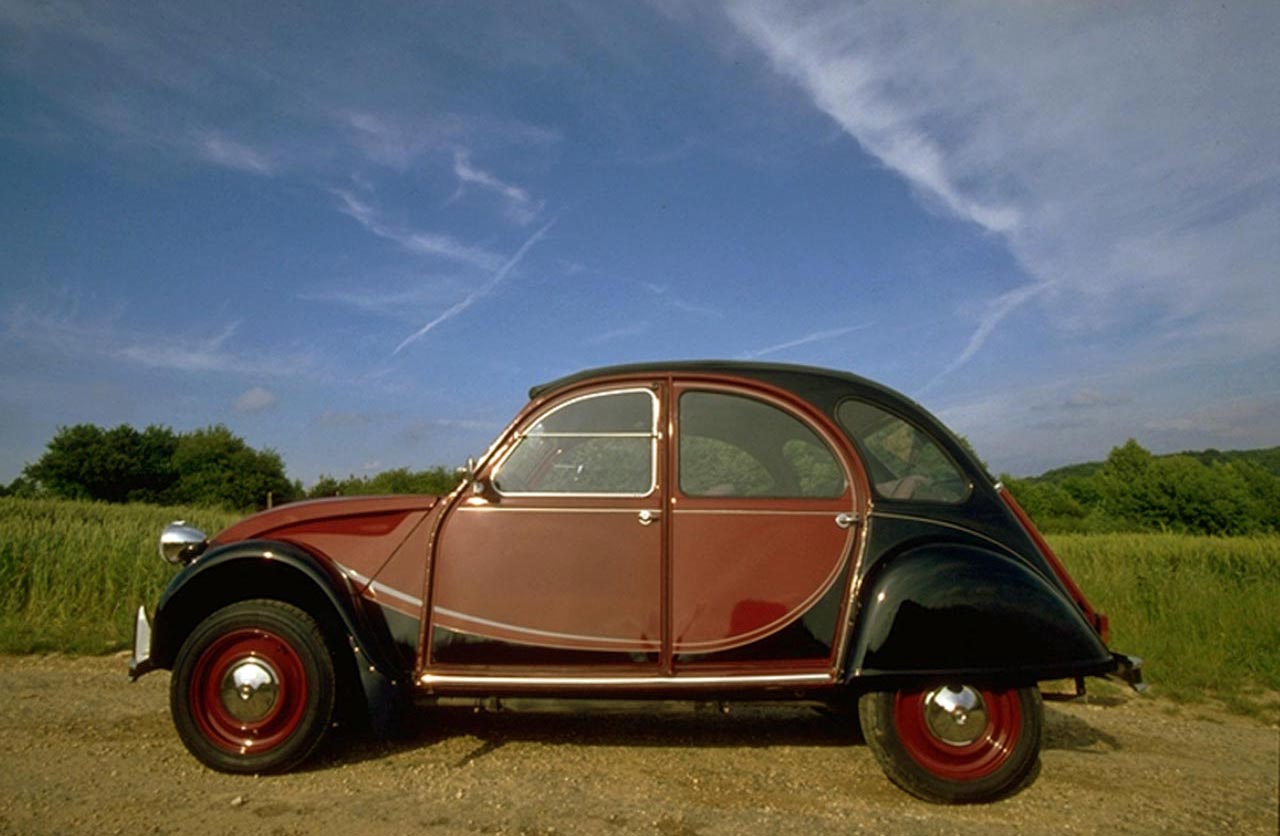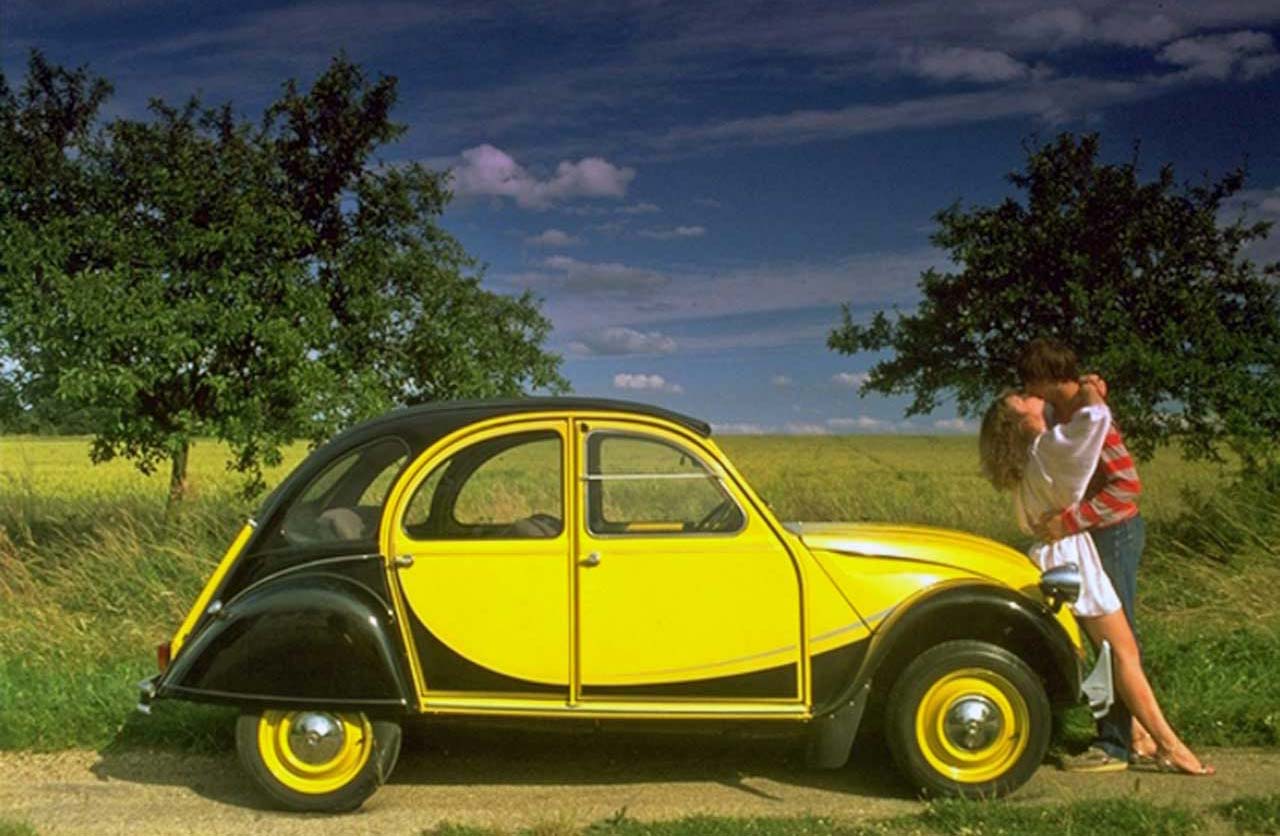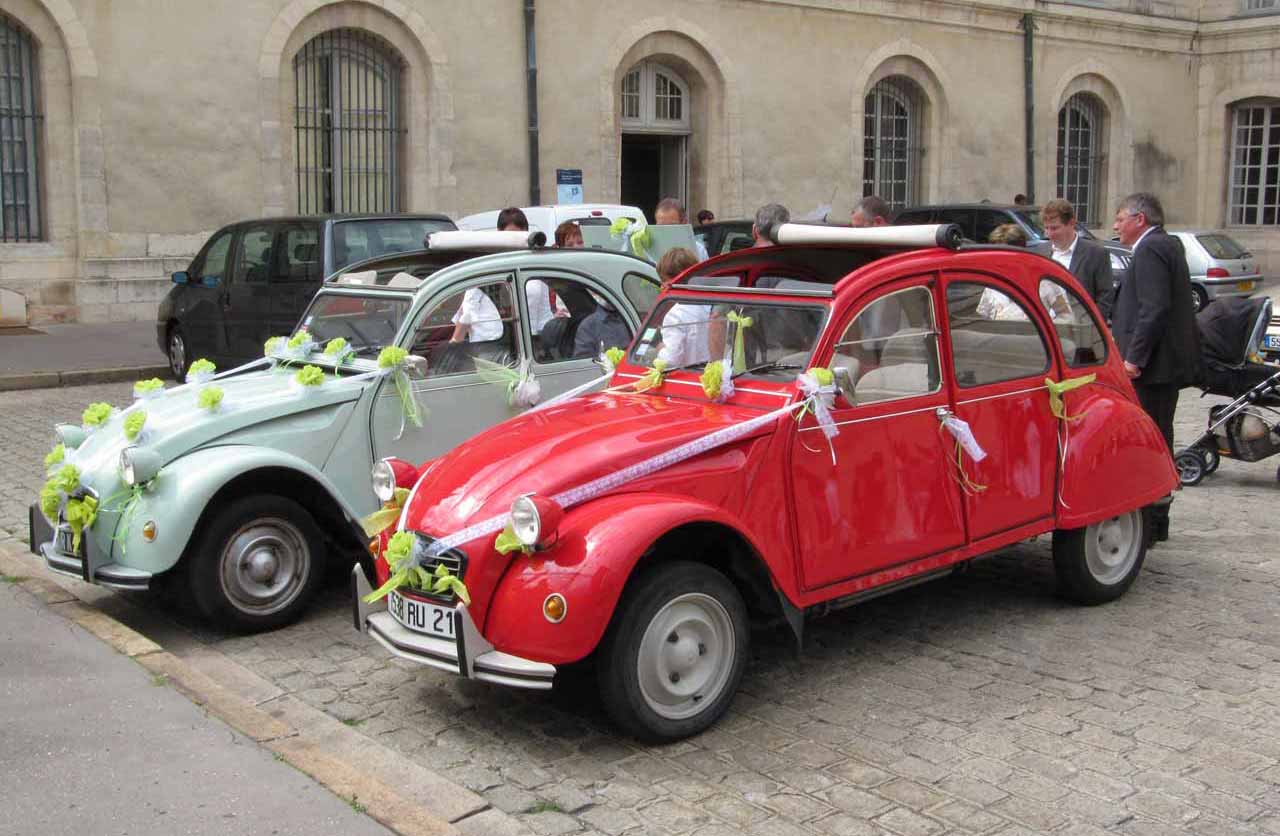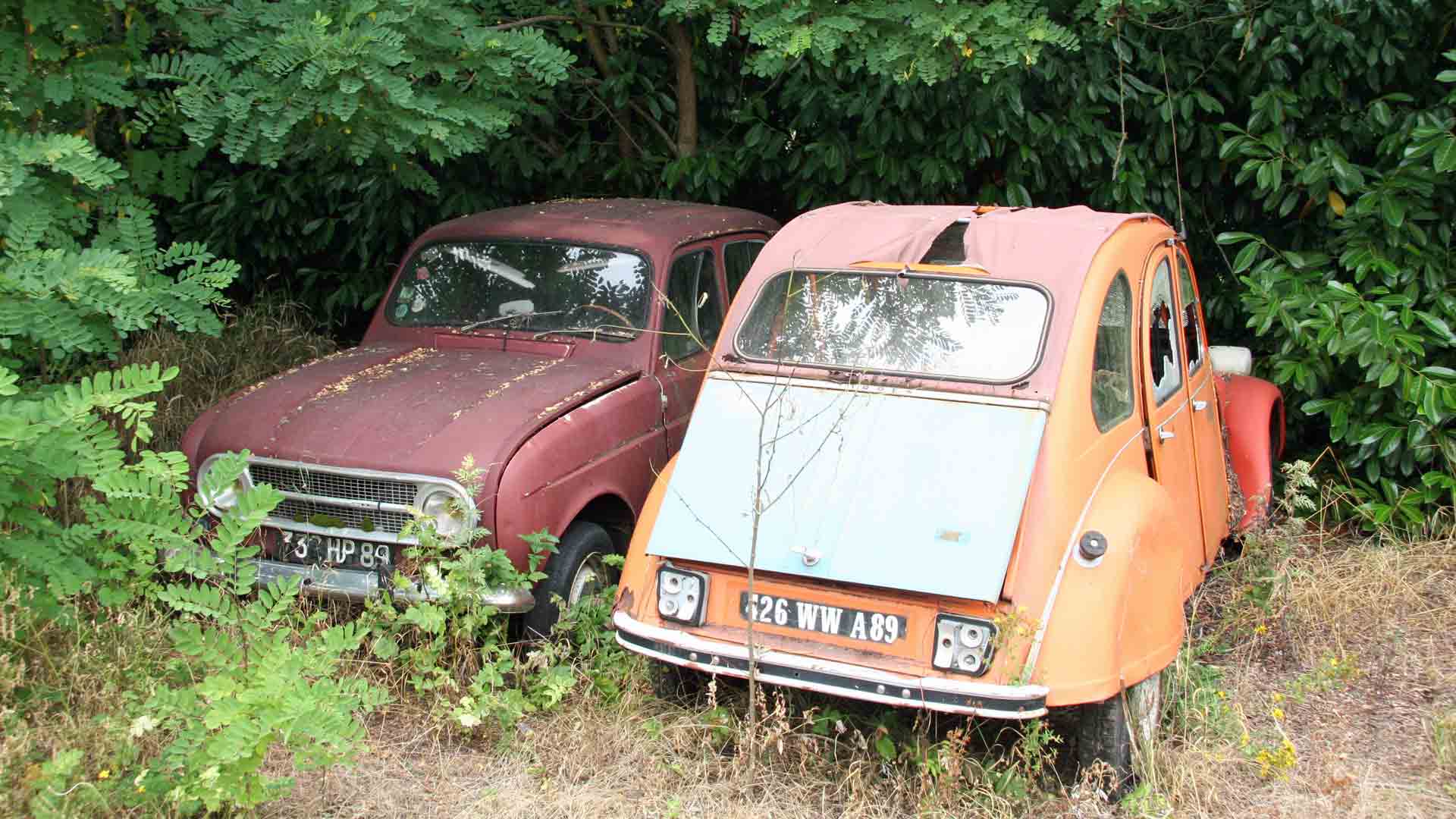- A car with a "Statement"
- Only in Germany: a car for university students
- Loved by the Germans
- Anticipation of the retro mainstream
- The first special model “Spot”
- The limited-edition special model Charleston
- “On behalf of her majesty”
- Variety of colors
- From naught to sixty in fifty-nine seconds
- Color variations of the restorers
- Model with a long tradition
- “Historical Incorrectness”
News from Duckburg
The “duck” is not only an institution, it is also a cult. Hardly any other car symbolizes more joie de vivre than it. For 43 years, the duck has been part of the Herpa program. It was one of the very first Herpa miniatures. New now is a Charleston duck in an unusual color combination.
The Germans have their Beetle, the French their “duck”, which the British sometimes call “umbrella on wheels” – or so, you would think. But this is not so. From the upheavals of 1968 onwards, or at the latest in the early 1970s in West Germany, the duck acquired the status of being the ultimate student swing, a symbol of non-conformist rebellion against the establishment. West Germany thus has its own relationship with the duck, never comparable to the status of “La Deuche” (as the French call the little Citroën) in its homeland. There, the 2CV is a purely pragmatic car and a rather rural phenomenon. In the cities of the 70s, people drove small cars with more chic, the Renault 5, for example, and if it had to be a Citroën, then the 2CV’s finer sister, the Dyane.
In a way, the first special model, although it was a basic version: the Citroën 2CV Spécial for the 1976 model year is a kind of the original 2CV, stripped down to the extreme, minimalist car driving. The Spécial was only available in bright yellow, without a third side window, round headlights again instead of the square ones. Back to the roots.
2CV Spécial from 1976. The sticker on the rear window is programmatic: “Ceci est plus qu’une voiture ... C’est un art de vivre”, in English: “This is more than a car ... it’s a way of life.”
A car with a “Statement”
Around the Sorbonne, the 2CV has never been a typical student car. Beetle and 2CV can never be compared in West Germany. That is a question of status. The Beetle is a classless vehicle, anyone can drive it. The duck never is. It is the vehicle of a social class par excellence, namely that of the left-wing alternative young academics in the 1970s and 1980s. There is hardly a duck without stickers à la “Nuclear power? No thanks” or the “Away with the Berufsverbot” sticker with an Albert Einstein sticking out his tongue.
This is a purely West German affair: the left-wing alternative student swing. Nuclear power? No thanks! A question answered in a friendly, polite manner, the best-known logo of the anti-nuclear movement. Danish student Anne Lund created the laughing red sun with a wax crayon in March 1975, and the logo spread rapidly across Europe by the millions.
The copyright is held by the Danish Organisationen til Oplysning om Atomkraft (Organization for Information on Nuclear Power), and anyone who wants to use the symbol (including the German party “Die Grünen”) must pay a symbolic license fee to the organization. The size of the largest sticker looks like having been made for the boot lid of the Citroën 2CV.
Only in Germany: a car for university students
The typical student swing just on the right bank of the river Rhine: the little Citroën has never been this rebellious attribute of a politically committed generation in France, only in West Germany. Before the Green Party existed, and especially after it did, the duck was the greenest car of all. This car was driven by everyone who, in one way or another in the 1970s, belonged to the broad spectrum of extra-parliamentary currents in the ecological, anti-nuclear, peace, and women’s movements, from which the German party “Die Grünen” (The Greens) was founded in January 1980. The ideology of these people also includes a hostility to technology and especially to cars. This aspect is interesting because the car enemies love the Citroën 2CV. Perhaps because it is so different that they don’t even perceive it as a car.
Still an integral part on the streets today and long since an established classic car: the 2CV Club from 1988 in front of the backdrop of Ulm’s Zundeltor.
Loved by the Germans
In the 1980s, Citroën hardly developed the 2CV any further, because successors à la Dyane or Visa had long been on the market, and in France, these cars could have replaced the 2CV long ago. But some export markets, especially Germany, still wanted the duck, so Citroën kept it alive and spiced it up with special models. The French said goodbye to the 2CV much earlier than the Germans. Sales in the home country ceased on February 28, 1989, as did production at Citroën’s Levallois plant. Future 2CVs would come from the Mangualde plant in Portugal. These were offered only in Germany, Belgium, and Portugal. On July 27, 1990, 2CV production finally came to an end. The last delivery of new cars reached Germany on September 11, 1990. More than five million Citroën 2CVs were produced between 1949 and 1990, and the total number of registrations in Germany was 348,078.
Anticipation of the retro mainstream
As with the Mexico Beetle, there were numerous special models of the duck in the 1980s, often with a nostalgic flair. It is not a step backwards, but in a way the visionary anticipation of the retro mainstream, which came en vogue years later and in the wake of which Citroën would produce the 2CV Charleston. The Citroën 2CV Spécial for the 1976 model year is a kind of archetypal 2CV, stripped down to the extreme, driving a car at the most elementary level. The Spécial was only available in Jaune Vif, had no third side window, round headlights again instead of the square ones (but with plastic lampcups), no chrome trim whatsoever, a simple soft top, a thin rear bumper, not even a chrome rim around the radiator grille, and inside, seats that were comfortable but couldn’t be beat for simplicity, and it had a simplified dashboard.
Bavarian-dressed ladies and a Citroën 2CV special model France 3 from April 1983 with non-original hubcaps. A second France 3 series was released in March 1984.
The first special model “Spot”
The 2CV Spécial is a serial production model, while its simultaneous and eye-catching sister named Spot is a special model limited to 1,800 units, and the first of a whole series of exclusive special editions. The Spot was released in April 1976 and is based on the 2CV 4. It is orange in color with white flanks featuring an orange stripe with the word “Spot” on it, and the interior is orange.The Spot is the first creation of Citroën’s stylist Serge Gevin, who was also responsible for the following special series. Also worth mentioning is the 2CV Basket, decorated in the style of a sneaker. It was the result of a competition, won by Claire Pagniez, and her design was realized exactly twice. The two vehicles still exist today.
Serge Gevin is the creator of all 2CV special series, and the 2CV 4 Spot in Ténéré orange and Meije white of 1976 was his first act. Special models based on other Citroëns also originate from his creativity, such as the GS Basalte, which Herpa also miniaturized.
The limited-edition special model Charleston
The year 1981 was marked by the Charleston. It was originally intended as a special model limited to 8,000 units (presented in October 1980), painted in delage red/black, and the arabesques on the sides recalling the rounded door shapes of the original 2CV prototype of 1936 and, as it were, the body of horse-drawn carriages. It was based on the 2CV Club, but wears the round headlights of the Spécial, initially painted red – as are the rims, graced by chrome Dyane hubcaps. Inside, the Charleston was snugly outfitted in a black-and-white checkered jersey fabric.
Very special advertising for the Charleston: the 1982 brochure is drawn as it was still common in the 1950s. Citroën advertising has always been different. Just as every Citroën is different from other cars.
“On behalf of her majesty”
In addition to the Charleston, Citroën launched a second special model, the “007” in an edition of 700. This was a must, after a yellow 2CV fought so valiantly against an armada of evil Peugeot 504s in the James Bond movie “For your eyes only”. Decorative bullet holes, only glued on, of course, decorated the “007” as well as the 007 logo.
A typical example for today’s variation of special models of that time: in 1983, the 2CV France 3 was released, always white with blue decoration. This duck enthusiast combined the blue stripes with light blue paint instead of white.
Variety of colors
From July 1981, the Charleston in delage red was a permanent part of the range, and for 1982, it received chrome lamp pots and new seat covers. In November 1982, the Charleston was released in a second color version, Hélios yellow with black; the red-and-black Charleston remained in the lineup. The yellow/black Charleston remained in the range for only one year, and was replaced in the autumn of 1983 by a new color combination, a harmony of medium gray and dark anthracite (cormorant gray/night green). Another special model delighted enthusiasts, the 2CV France 3 in the spring of 1983, a white car based on the Club with round headlights and blue wavy stripes on the flanks and a double stripe, also blue, across the hood, the soft top, and the boot lid. The France 3 is a sailboat that was successful in the America’s Cup, a round-the-world race.
The Gauloises ducks are legendary. The cigarette brand had various one-offs realized, which could be won by industrious smokers. A small insight into the wide range of Gauloises ducks: long, short, floatable, in retro look, as convertible – nothing was impossible, and each one is a unique piece.Advertising for the Gauloises ducks. Each one was handcrafted, made by a Hamburg coachbuilder on behalf of the German Gauloises importer.
From naught to sixty in fifty-nine seconds
In March 1985, Citroën launched the first special Dolly series (3,000 units) in gray/yellow, gray/green, and gray/red, followed in October by the second series (2,000 units) in green/white, red/white, and red/yellow, and in spring 1986 by the third series (2,000 units) in yellow/dark blue, red/white, and red/yellow. Limited to 1,500 units was the 1986 Citroën-Germany special model, Duck-Green, in a green two-tone Charleston-style paint scheme, with an “I fly unleaded” lettering on the sides and a corresponding engine that could handle the then-new unleaded gasoline. An all-French special model was the 2CV Cocorico (French for cock-a-doodle-doo) to mark French hopes of winning the soccer world cup, which did not materialize. The Cocorico was white, the flanks blue/red (the French national colors), denim seat covers inside, and there were 1,000 of them. Citroën-Germany released another special model in 1987, the “Sausss-Ente”, painted very similarly to the “I-fly-bleifrei” model, but with the ironic flank lettering “0–100 km/h in 59.4 sec.” and decorated with a duck wearing a crash helmet.
Celebrity duck: the well-known baritone Hermann Prey with his 2CV 6. The car sports the optional winter radiator grille with a smaller air passage to allow it to reach operating temperature more quickly.
Color variations of the restorers
Thus, a 2CV Charleston is conceivable in three color combinations. Dark red with black as the classic combination, light gray combined with dark gray looks very elegant, yellow with black in stagecoach manner was exciting, but short-lived and apparently not very popular. And what about the blue/black combination, Herpa’s new release? It was not historically correct, it never existed ex works. But what is not historically correct does not necessarily have to be fictitious. There is now a lively 2CV scene in France, and varying the colors of the special models is a fashion among duck restorers. This works especially well because quite a few special models get their charm from special stickers that are reproduced today. It is currently even possible to rebuild the 2CV special model Chic from 1986 which only existed as a prototype and never went into serial production, dark gray fowl (“gris nocturne”) with white fenders (Meije white) and curved side decals, also in white and with a red accent. The set of decals can be bought for a bit of money and can be used to realize a duck that actually never existed. Decals for the 1976 special series Spot, in the original only in orange with white flanks, are also available, so that Spots in all conceivable colors can be created with them. And they don’t even have to be real ducks. Spot special models are known from a box duck or even an Acadiane, the Dyane-based delivery van. It seems to be a sheer pleasure for the French duck enthusiasts to confuse the viewers with pseudo-special series. Thus, a blue Charleston duck is both conceivable and presentable, although simply not historically correct.
It didn’t exist, but it still does: the original 1976 Spot duck has always been orange with white flanks. Herpa realized it in sky blue, which does not correspond to the original, but to the reality of today’s French 2CV community
Model with a long tradition
Hardly any currently available Herpa model can look back on such a long tradition as the 2CV. The Herpa model car series was released in 1978, and in 1979, as part of the new releases, foreign originals were introduced for the first time: the Jaguar XJ6 Series III, the Citroën 2CV, and the Renault 4. This means that the little Herpa duck is already 43 years old and still looks fresh. Herpa initially manufactured the then-current model with the controversial rectangular headlights (from 1974) with the top closed. In the course of time, there came the version with a half-opened roll top, and standard wheels became type-specific rims with separate tires. Herpa put its printing skills to use early on with the duck. In 1980, for example, the 2CV became available in dark blue or red with two yellow ducks on each front door, and the following year, the lavishly printed Bavarian duck with a blue-and-white diamond pattern was introduced. Apart from the option of an open or closed roll-top roof, variations in shape remain rare, and in 2015, the version with a retrofitted enlarged boot arrived.
“Historical Incorrectness”
Herpa has often played with imprints and with colors. Right at the beginning, the duck joined its band of brothers and, like every Herpa passenger car, was available in both solid and metallic paint. This was, as far as we can tell, Herpa’s first “historical incorrectness” with the duck, as metallic paints were never available as standard for the 2CV. If you are looking for other mistakes in the past, you will find them and can smile about them: a blue 2CV Spot in 2008 in a special model set and a dark red/black Charleston from 1990, which is painted the wrong way round, i.e. a black duck with dark red decoration. Whatever! Collectors consider such a faux pas a kind of “Blue Mauritius” amidst all the beautiful ducks Herpa has made so far. Unforgotten is the green 1987 Sausss duck, realized by Herpa in 1991, which is a marvel of printing art.
And in 1996, the 2CV even served as a Herpa trade fair model, at that time not yet in the uniform “trade fair red” that is common today. In 1996, Herpa sprayed the 2CV in the German taxi color light ivory and put a cab sign on its roof. Was that possible? Of course not! But it is a gag, and a pretty model to boot. That’s exactly how you have to perceive the blue/black Charleston duck: a nice model, a conceivable version that didn’t exist off the assembly line, but that could show up at any duck meeting in France. A car that will baffle the less ingenious crowd and make the insiders grin. Duck collectors, at any rate, are delighted with every version of Herpa’s long-time bestseller. Those who specialize in the Herpa 2CV and actually have every version from the past 43 years in their showcase will need quite a bit of shelf space.
The two eternal rivals in the final stages: Renault R4 and Citroën 2CV in Arcy-sur-Cure, a tiny spot in Burgundy, photographed in summer 2011.
Report: Alexander Franc Storz
Pictures: Archive Storz and factory photos of Citroën
Numbers, data, facts
In France, the Citroën 2CV is called “La Deuche” for short, meaning “The Two”. This is the shortening of its official name 2CV (deux chevaux, i.e. “two horses”) and refers to the tax horsepower valid in France, of which the 2CV has two. The 2CV got its official name in France in 1959, namely Monpti.
This is a character in a novel by Gábor von Vaszary, a popular play on words in France. It is the dialectal abbreviation of “mon petit”, which means “my little one”. Monpti, however, never caught on. The Citroën 2CV has its own nickname in many countries. In Germany, it is called “hässliches Entlein” (ugly duckling), or just “die Ente” for short.
This was never official, but was included in later special models by the German sales company (Sausss-Ente, Ente-grün). This term can be found in later sales brochures. The magazine Auto Motor Sport referred to the 2CV in a first test in 1954 as an “ugly country road bug”. In the English-speaking world, “ugly duckling” prevailed, as well as “umbrella on wheels”.

